Standard Chartered Bundle
Unveiling Standard Chartered's Customer Base: Who Are They?
Standard Chartered, a global financial powerhouse, has evolved significantly since its inception. Understanding its customer demographics and target market is paramount to its continued success. From its roots in colonial trade to its current global presence, the company's focus has shifted dramatically. This exploration delves into the heart of Standard Chartered's customer strategy.
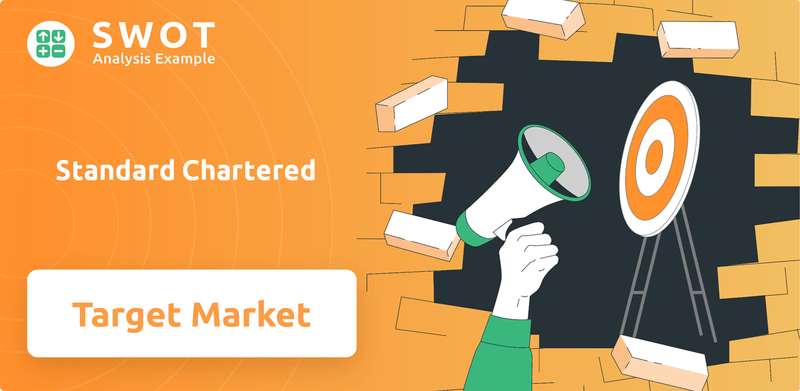
The Standard Chartered SWOT Analysis highlights the company's strengths, weaknesses, opportunities, and threats, all of which are intrinsically linked to its customer profile. Analyzing who Standard Chartered's target customers are, including their age range, income levels, and geographic location, is crucial. This analysis will provide insights into how Standard Chartered tailors its products and services to meet the needs and wants of its diverse clientele, driving customer acquisition and fostering lasting relationships.
Who Are Standard Chartered’s Main Customers?
Understanding the customer demographics and target market of Standard Chartered is crucial for grasping its business strategy. The bank focuses on distinct segments, tailoring its services to meet specific needs. This approach allows Standard Chartered to optimize its offerings and maintain a competitive edge in diverse markets.
Standard Chartered's customer profile is shaped by its global presence and focus on emerging markets. The bank serves a variety of clients, from high-net-worth individuals to multinational corporations. This segmentation strategy allows the bank to provide specialized services, enhancing customer satisfaction and driving growth.
The bank's primary customer segments are Corporate & Investment Banking (CIB), Wealth & Retail Banking (WRB), and institutional clients. Each segment is designed to cater to specific financial needs, reflecting Standard Chartered's commitment to a diversified and customer-centric approach. This strategy is key to its success in various regions.
The WRB segment targets affluent clients, particularly in Asia, Africa, and the Middle East. In 2024, Standard Chartered onboarded 265,000 new affluent clients. This segment is a key driver of growth, with the bank setting ambitious targets of $200 billion in net new money from 2025 to 2029.
CIB focuses on providing cross-border solutions for businesses and institutions. In 2024, CIB's cross-border network income was $7.3 billion, representing 61% of its total CIB income. The bank leverages its extensive network across Asia, Africa, and the Middle East to serve this segment effectively.
Standard Chartered's strategy is designed to capitalize on opportunities in key markets. The bank's focus on affluent clients in WRB and cross-border solutions in CIB highlights its commitment to growth and customer satisfaction. For more insights, see the Growth Strategy of Standard Chartered.
- Wealth & Retail Banking: Focuses on affluent clients, with significant growth in net new money and wealth solutions operating income. The bank aims for double-digit income compound annual growth rate (CAGR) in Wealth Solutions from 2024 to 2029.
- Corporate & Investment Banking: Provides cross-border solutions, with a significant portion of its income derived from its extensive global network. The bank's digital transformation enhances services for both corporate and retail clients.
- Digital Banking Initiatives: Includes ventures like Mox Bank in Hong Kong and Trust Bank in Singapore, serving digitally-savvy customers and those building wealth.
- Geographic Focus: Operations span across Asia, Africa, and the Middle East, targeting diverse customer demographics.
Standard Chartered SWOT Analysis
- Complete SWOT Breakdown
- Fully Customizable
- Editable in Excel & Word
- Professional Formatting
- Investor-Ready Format
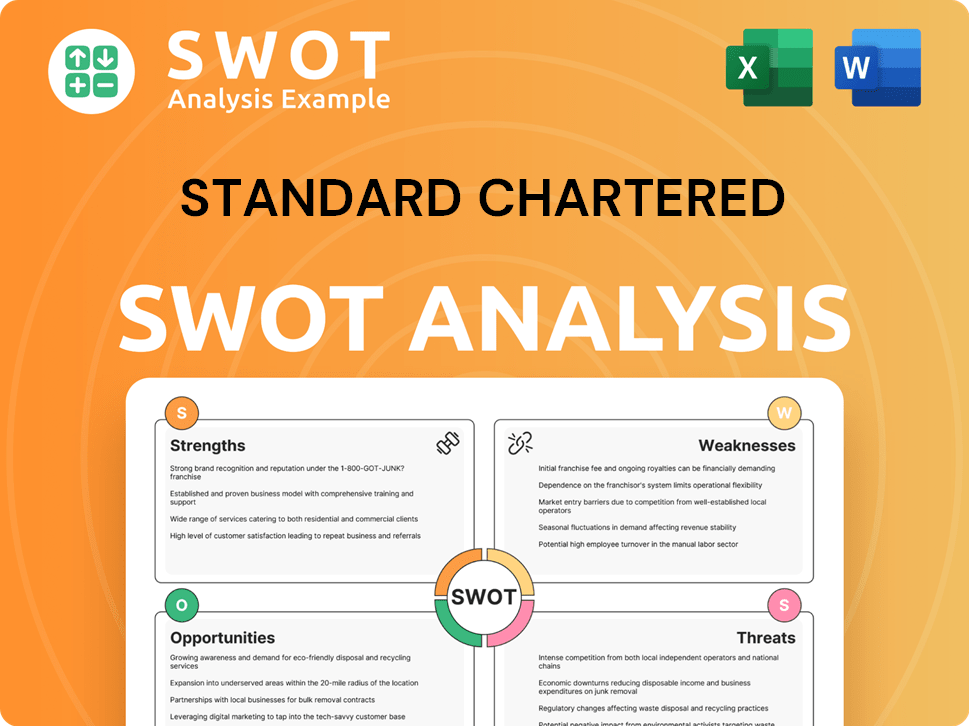
What Do Standard Chartered’s Customers Want?
Understanding the needs and preferences of its customers is crucial for the success of Standard Chartered. The bank focuses on delivering tailored financial solutions to meet the diverse demands of its customer base, which includes affluent individuals and corporate clients. This customer-centric approach drives product development and service improvements, ensuring high levels of satisfaction and loyalty.
Standard Chartered's commitment to understanding its customers is evident in its proactive engagement strategies. By gathering feedback and analyzing market trends, the bank continually refines its offerings to stay ahead of evolving customer expectations. This focus on customer needs enables the bank to maintain a competitive edge and foster long-term relationships with its clients.
The bank's affluent clients, a key segment within the Marketing Strategy of Standard Chartered, seek sophisticated wealth management solutions. These include investment products, insurance, and personalized financial advice. Standard Chartered caters to these needs by providing comprehensive services designed to grow and protect their clients' assets. The bank's performance in Wealth Solutions, with a 29% income increase in 2024, highlights its success in meeting these demands.
Corporate and institutional clients prioritize efficiency and transparency in their financial operations. Standard Chartered provides solutions that enable businesses to manage complex global trade and investments effectively. The bank's investment in digital capabilities, such as FX trading and platforms like 'Trade Track-It,' exemplifies its commitment to meeting these needs.
- Affluent clients value wealth management solutions, including investments and personalized advice.
- Corporate clients require efficient cross-border capabilities and real-time services.
- The bank actively engages clients through initiatives like 'SC Inner Circle' to gather feedback and improve services.
- Standard Chartered focuses on sustainable finance, which generated $982 million in income in 2024 and is on track to reach $1 billion in 2025.
Standard Chartered PESTLE Analysis
- Covers All 6 PESTLE Categories
- No Research Needed – Save Hours of Work
- Built by Experts, Trusted by Consultants
- Instant Download, Ready to Use
- 100% Editable, Fully Customizable
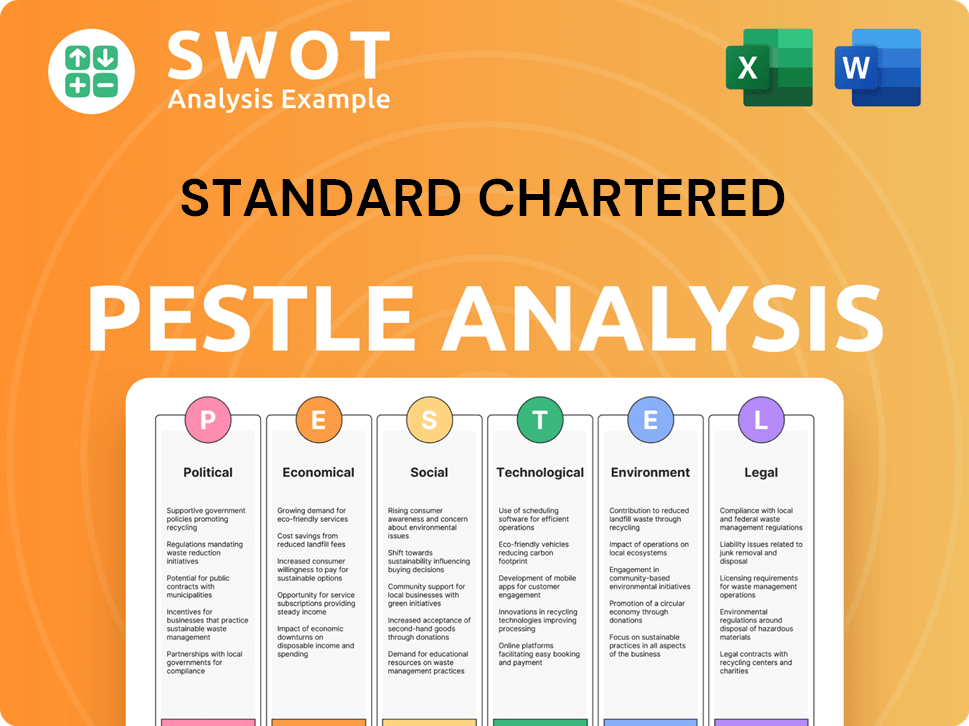
Where does Standard Chartered operate?
The geographical market presence of Standard Chartered is extensive, spanning across 53 markets worldwide. The bank strategically focuses on dynamic regions including Asia, Africa, the Middle East, Europe, and the Americas. This broad reach allows it to serve a diverse range of customers and tap into various economic opportunities.
A significant portion of Standard Chartered's sustainable finance assets, approximately 80%, are concentrated in Asia, Africa, and the Middle East. These regions are considered high-growth markets. The bank positions itself as a 'super connector' within these areas, facilitating global trade and investment flows. This strategic focus underscores its commitment to these key markets and their growth potential.
Standard Chartered's approach involves localizing its offerings and marketing strategies to resonate with the specific needs of each market. For example, to celebrate its 120-year presence in Vietnam, the bank launched the Standard Chartered Hanoi Marathon Heritage Race in 2024. This demonstrates a commitment to engaging with local communities and tailoring its services to meet regional demands. For more information about the bank's financial strategies, you can read about the Revenue Streams & Business Model of Standard Chartered.
The Gulf Cooperation Council (GCC) countries, including Saudi Arabia, UAE, and Qatar, are expected to be a bright spot for global growth in 2025, driven by non-oil sector growth and strategic investments. China's economy is projected to grow by 4.5% in 2025, supported by expansionary fiscal policies. In Africa, countries like Benin, Côte d'Ivoire, Ethiopia, and Kenya are anticipated to achieve strong growth rates in 2025.
The bank's geographic diversification is a source of resilience against macroeconomic conditions and trade tariffs. Only seven market corridors generate over $100 million in network income annually, indicating a balanced global presence rather than over-reliance on a few. This diversified presence helps mitigate risks and capitalize on opportunities across various regions.
Several African nations are poised for significant growth in 2025, fueled by industrial expansion, infrastructure development, and advancements in digital technology. Kenya, for instance, is projected to experience a GDP growth of 4.7% in 2025. These developments highlight the bank's strategic positioning to benefit from Africa's economic potential.
Standard Chartered Business Model Canvas
- Complete 9-Block Business Model Canvas
- Effortlessly Communicate Your Business Strategy
- Investor-Ready BMC Format
- 100% Editable and Customizable
- Clear and Structured Layout
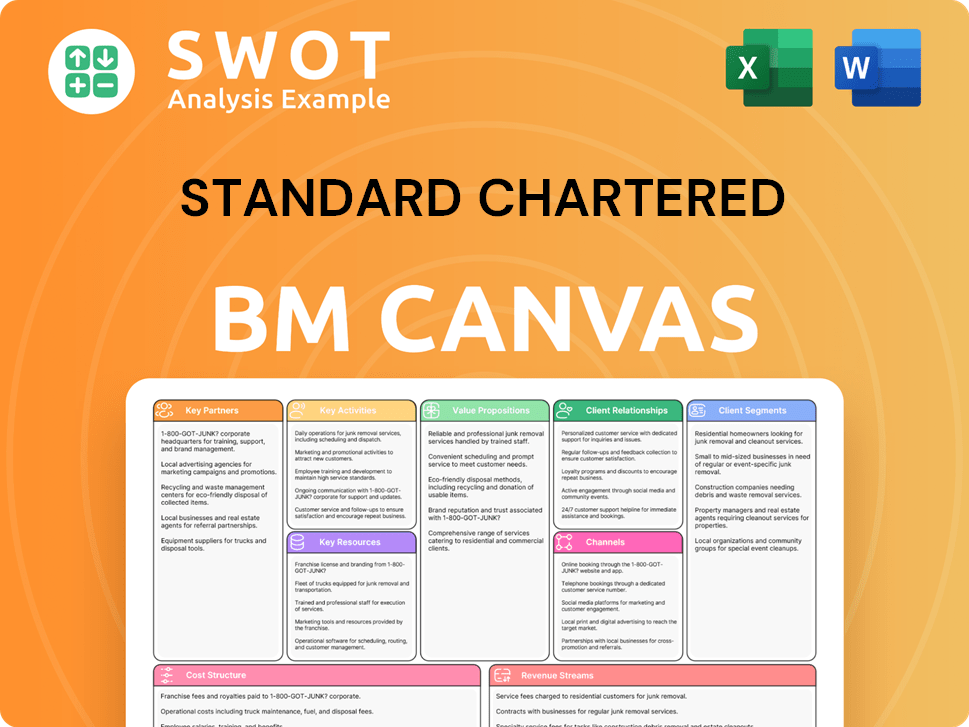
How Does Standard Chartered Win & Keep Customers?
Understanding the customer acquisition and retention strategies of a financial institution like the one is crucial for assessing its market position and growth potential. The bank's approach is multifaceted, focusing on digital innovation, wealth management, and global reach. This strategy aims to attract and retain a diverse customer base, from retail clients to high-net-worth individuals, and corporate entities.
The bank's commitment to digital transformation is evident in its investments in the SC Mobile app, which saw a 10% increase in digital user count in 2023, with 90% of users actively engaging with the platform. This digital focus, combined with personalized customer experiences driven by feedback, has led to industry recognition for digital customer experience. For affluent clients, the bank's strategy involves expanding its wealth management services, which has resulted in significant new client onboarding.
Marketing efforts are supported by a MarTech ecosystem, partnerships, and a commitment to sustainable finance. These initiatives align with the bank's brand promise and values, fostering trust and loyalty among its customers. The bank's customer acquisition strategy is further enhanced by its focus on sustainable finance, which generated $982 million in income in 2024.
The bank emphasizes a top-notch digital banking experience by redesigning its SC Mobile app. This strategy simplifies online banking and makes it faster and easier for customers. The bank's investment in digital platforms has led to a significant increase in digital user engagement.
For affluent clients, the bank builds its team of investment advisors and relationship managers. It also enhances wealth solutions and capabilities to attract and retain high-net-worth individuals. This focus has led to strong new client onboarding.
The bank utilizes customer feedback and research, such as the 'SC Inner Circle' community. This helps drive personalized and enhanced customer experiences. These efforts have resulted in awards for digital customer experience.
The bank invests in sustainable finance through partnerships and platforms like Algbra. This commitment aligns with societal values and serves as a differentiator. This strategy has generated significant income, highlighting its impact on customer acquisition.
The bank's target market includes a wide range of customers, from retail clients to high-net-worth individuals and corporate entities. It focuses on providing tailored services to meet the diverse needs of its customer base. The bank's customer profile is defined by its segmentation strategy.
The bank caters to a broad age range, from young professionals using digital banking platforms to older, affluent clients seeking wealth management services. Its services are designed to appeal to various life stages and financial needs. The bank's approach ensures it meets the needs of a diverse customer base.
The bank conducts detailed target market analysis to understand customer needs and preferences. This analysis informs its product development, marketing strategies, and customer service initiatives. The bank uses data and research to refine its approach to its target market.
The customer base of the bank is diverse, spanning various demographics and geographic locations. This diversity is a result of the bank's global presence and range of financial products and services. The bank's customer base includes retail, affluent, and corporate clients.
The bank serves customers across various income levels, with a particular focus on affluent clients through its wealth management services. It provides services tailored to different income brackets to meet their financial needs. The bank offers a range of products to suit different income levels.
The bank operates in multiple geographic locations, with a strong presence in Asia, Africa, and the Middle East. Its global footprint allows it to serve a diverse customer base across different regions. The bank's international presence is a key aspect of its customer acquisition strategy.
The bank employs a multifaceted customer acquisition strategy that includes digital transformation, wealth management services, and sustainable finance initiatives. These strategies are designed to attract new customers and enhance customer loyalty. For a deeper dive into the bank's growth strategy, you can read this article: Growth Strategy of Standard Chartered.
- Digital Banking: Enhancing the SC Mobile app and online platforms.
- Wealth Management: Expanding investment advisory and relationship management teams.
- Sustainable Finance: Investing in platforms like Algbra.
- Marketing Channels: Utilizing a MarTech ecosystem and partnerships.
Standard Chartered Porter's Five Forces Analysis
- Covers All 5 Competitive Forces in Detail
- Structured for Consultants, Students, and Founders
- 100% Editable in Microsoft Word & Excel
- Instant Digital Download – Use Immediately
- Compatible with Mac & PC – Fully Unlocked
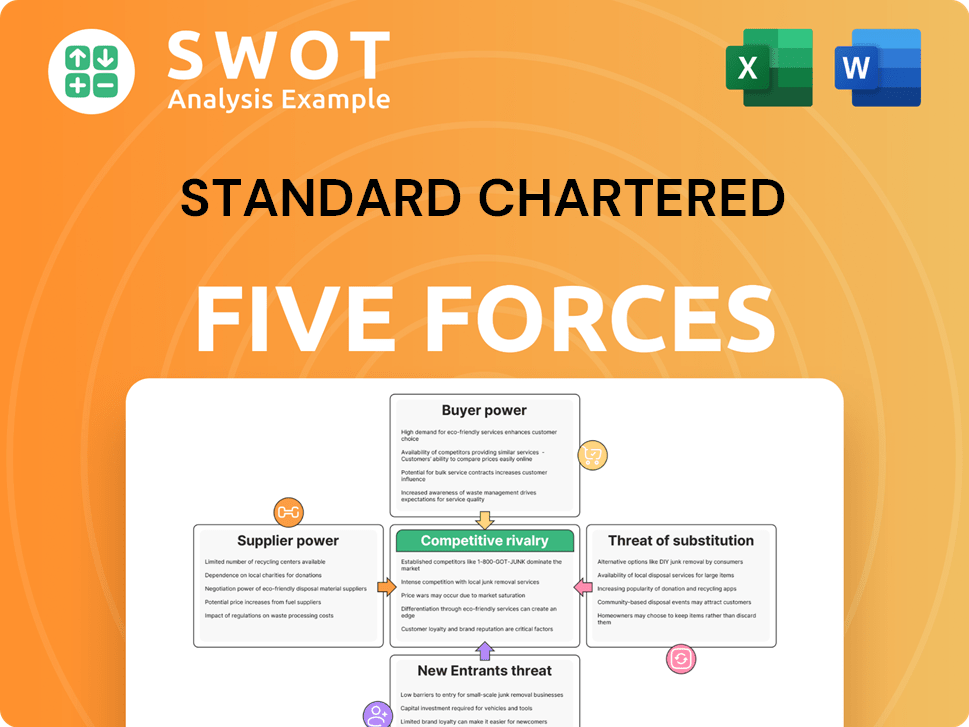
Related Blogs
- What are Mission Vision & Core Values of Standard Chartered Company?
- What is Competitive Landscape of Standard Chartered Company?
- What is Growth Strategy and Future Prospects of Standard Chartered Company?
- How Does Standard Chartered Company Work?
- What is Sales and Marketing Strategy of Standard Chartered Company?
- What is Brief History of Standard Chartered Company?
- Who Owns Standard Chartered Company?
Disclaimer
All information, articles, and product details provided on this website are for general informational and educational purposes only. We do not claim any ownership over, nor do we intend to infringe upon, any trademarks, copyrights, logos, brand names, or other intellectual property mentioned or depicted on this site. Such intellectual property remains the property of its respective owners, and any references here are made solely for identification or informational purposes, without implying any affiliation, endorsement, or partnership.
We make no representations or warranties, express or implied, regarding the accuracy, completeness, or suitability of any content or products presented. Nothing on this website should be construed as legal, tax, investment, financial, medical, or other professional advice. In addition, no part of this site—including articles or product references—constitutes a solicitation, recommendation, endorsement, advertisement, or offer to buy or sell any securities, franchises, or other financial instruments, particularly in jurisdictions where such activity would be unlawful.
All content is of a general nature and may not address the specific circumstances of any individual or entity. It is not a substitute for professional advice or services. Any actions you take based on the information provided here are strictly at your own risk. You accept full responsibility for any decisions or outcomes arising from your use of this website and agree to release us from any liability in connection with your use of, or reliance upon, the content or products found herein.